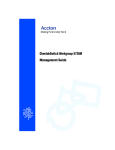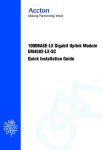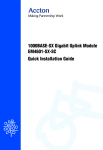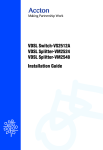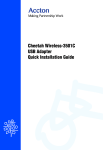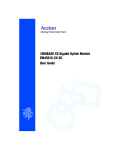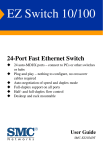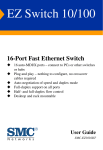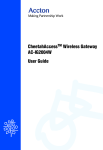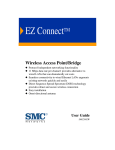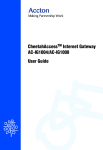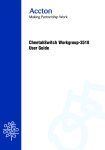Download Accton Technology CheetahSwitch Workgroup-3726M Installation guide
Transcript
CheetahSwitch Workgroup-3726M Quick Installation Guide Quick Installation Guide CheetahSwitch Workgroup-3726M Intelligent/Stackable Fast Ethernet Switch with 24 10BASE-T / 100BASE-TX (RJ-45) Ports, and Optional Media Expansion and Stack Modules Copyright © 2002 by Accton Technology Corporation. All rights reserved. No part of this document may be copied or reproduced in any form or by any means without the prior written consent of Accton Technology Corporation. Accton makes no warranties with respect to this documentation and disclaims any implied warranties of merchantability, quality, or fitness for any particular purpose. The information in this document is subject to change without notice. Accton reserves the right to make revisions to this publication without obligation to notify any person or entity of any such changes. On-line Registration For quick warranty registration, log on our website at http://register.acctontech.com to register your Accton products. International Headquarters No. 1 Creation Road III, Science-based Industrial Park Hsinchu 300, Taiwan, R.O.C. Phone: +886-3-5770-270 Fax: +886-3-5770-267 Internet: [email protected] Europe Headquarters Edificio Conata II, Calle Fructuós Gelabert 6-8, 2o, 4a, 08970 - Sant Joan Despí, Barcelona, Spain. Phone: +34-93-477-4920 Fax: +34-93-477-3774 Asia Pacific Headquarters 1 Claymore Drive #08-05/06 Orchard Towers (Rear Block) Singapore 229594 Phone: +65 238 6556 Fax: +65 238 6466 Internet: www.acctontech.com USA Headquarters 6 Hughes Irvine, CA 92618 Phone Numbers: Sales: +800-926-9288 Support: +888-398-4101 or +949-707-4847 RMA: +800-762-4968 Fax: +949-707-2460 Accton is a trademark of Accton Technology Corporation. Other trademarks or brand names mentioned herein are trademarks or registered trademarks of their respective companies. AC-ES3726M E012002-R01 F2.476 150200008100A Limited Warranty Accton Technology Corporation Limited Warranty: Accton warrants all is products to be free of manufacturing defects in workmanship and materials, under normal use and service, for the applicable warranty term. All Accton products carry a standard 90-day limited warranty from the date of purchase from Accton or its Authorized Reseller. Accton may, at its own discretion, repair or replace any product not operating as warranted with a similar or functionally equivalent product, during the applicable warranty term. The standard limited warranty can be upgraded to a Limited Lifetime* warranty by registering new products within 30 days of purchase from Accton or its Authorized Reseller. Registration can be accomplished via the enclosed product registration card or online via the Accton web site. Failure to register will not affect the standard limited warranty. The Limited Lifetime warranty covers a product during the Life of that Product, which is defined as the period of time during which the product is an ‘Active’ Accton product. A product is considered to be ‘Active’ while it is listed on the current Accton price list. As new technologies emerge, older technologies become obsolete and Accton will, at its discretion, replace an older product in its product line with one that incorporates these newer technologies. At that point, the obsolete product is discontinued and is no longer an ‘Active’ Accton product. A list of discontinued products is attached with the firmware, configuration information, or memory data of Customer contained in, stored on, or integrated with any products returned to Accton pursuant to any warranty. Products returned to Accton should have any customer-installed accessory or add-on components, such as expansion modules, removed prior to returning the product for replacement. Accton is not responsible for these items if they are returned with the product. Customers must contact Accton for a Return Material Authorization number prior to returning any product to Accton. Proof of purchase may be required. Any product returned to Accton without a valid Return Material Authorization (RMA) number clearly marked on the outside of the package will be returned to customer at customer’s expense. Customers are responsible for all shipping charges from their facility to Accton. Accton is responsible for return shipping charges from Accton to customer. WARRANTIES EXCLUSIVE: IF AN ACCTON PRODUCT DOES NOT OPERATE AS WARRANTED ABOVE, CUSTOMER’S SOLE REMEDY SHALL BE REPAIR OR REPLACEMENT OF THE PRODUCT IN QUESTION, AT ACCTON’S OPTION. THE FOREGOING WARRANTIES AND REMEDIES ARE EXCLUSIVE AND ARE IN LIEU OF ALL OTHER WARRANTIES OR CONDITIONS, EXPRESS OR IMPLIED, EITHER IN FACT OR BY OPERATION OF LAW, STATUTORY OR OTHERWISE, INCLUDING WARRANTIES OR CONDITIONS OF MERCHANTABILITY AND FITNESS FOR A PARTICULAR PURPOSE. ACCTON NEITHER ASSUMES NOR AUTHORIZES ANY OTHER PERSON TO ASSUME FOR IT ANY OTHER LIABILITY IN CONNECTION WITH THE SALE, INSTALLATION, MAINTENANCE OR USE OF ITS PRODUCTS. ACCTON SHALL NOT BE Limited Warranty LIABLE UNDER THIS WARRANTY IF ITS TESTING AND EXAMINATION DISCLOSE THE ALLEGED DEFECT IN THE PRODUCT DOES NOT EXIST OR WAS CAUSED BY CUSTOMER'S OR ANY THIRD PERSON'S MISUSE, NEGLECT, IMPROPER INSTALLATION OR TESTING, UNAUTHORIZED ATTEMPTS TO REPAIR, OR ANY OTHER CAUSE BEYOND THE RANGE OF THE INTENDED USE, OR BY ACCIDENT, FIRE, LIGHTNING, OR OTHER HAZARD. LIMITATION OF LIABILITY: IN NO EVENT, WHETHER BASED IN CONTRACT OR TORT (INCLUDING NEGLIGENCE), SHALL ACCTON BE LIABLE FOR INCIDENTAL, CONSEQUENTIAL, INDIRECT, SPECIAL, OR PUNITIVE DAMAGES OF ANY KIND, OR FOR LOSS OF REVENUE, LOSS OF BUSINESS, OR OTHER FINANCIAL LOSS ARISING OUT OF OR IN CONNECTION WITH THE SALE, INSTALLATION, MAINTENANCE, USE, PERFORMANCE, FAILURE, OR INTERRUPTION OF ITS PRODUCTS, EVEN IF ACCTON OR ITS AUTHORIZED RESELLER HAS BEEN ADVISED OF THE POSSIBILITY OF SUCH DAMAGES. SOME COUNTRIES DO NOT ALLOW THE EXCLUSION OF IMPLIED WARRANTIES OR THE LIMITATION OF INCIDENTAL OR CONSEQUENTIAL DAMAGES FOR CONSUMER PRODUCTS, SO THE ABOVE LIMITATIONS AND EXCLUSIONS MAY NOT APPLY TO YOU. THIS WARRANTY GIVES YOU SPECIFIC LEGAL RIGHTS, WHICH MAY VARY FROM STATE TO STATE. NOTHING IN THIS WARRANTY SHALL BE TAKEN TO AFFECT YOUR STATUTORY RIGHTS. * Accton will provide warranty service for up to three years following discontinuance from the active Accton price list. Under the limited lifetime warranty, internal and external power supplies, fans, and cables are covered by a standard one-year warranty from date of purchase. Contents Introduction 1 Installing the Switch Package Contents Description of Hardware Mounting the Switch Stacking Switches on a Flat Surface Mounting Switches in a Rack Installing a Management Module Installing Optional Media and Stacking Modules Connecting to the Stack’s Backplane Connecting the Switch System Making a Connection to an RJ-45 Port Connecting to a 100BASE-FX Port Connecting to a Gigabit Fiber Optic Port Powering On the Switch Verifying Port Status Verifying System Operation Applications 2 2 2 3 3 4 4 4 5 6 6 7 7 8 9 9 10 Product Specifications Base Unit Physical Characteristics Switching Criteria Traffic Control Modules Management Module (AC-ES3726M-AGENT) 100BASE-FX Module (EM3582-FX-SC) 1000BASE-SX Module (EM4582-SX-SC) 1000BASE-LX Module (EM4582-LX-SC) Stacking Module (EM3580-STACK) 11 11 11 12 12 12 12 12 13 13 13 Troubleshooting Diagnosing Switch Indicators Power and Cooling Problems Installation 13 13 14 14 Port and Cable Assignments RJ-45 Port Description Straight-Through Wiring Crossover Wiring 15 15 15 15 EMI Certification FCC Class A Certification (USA) 16 16 i Contents Canada Department of Communications - Class A BSMI Class A (Taiwan) VCCI Class A Compliance (Japan) CE Mark Declaration of Conformance for EMI and Safety (EEC) 16 16 16 17 Safety Compliance Warning: Fiber Optic Port Safety Avertissment: Ports pour fibres optiques - sécurité sur le plan optique Warnhinweis: Faseroptikanschlüsse - Optische Sicherheit Underwriters Laboratories Inc. (USA) Wichtige Sicherheitshinweise (Germany) 18 18 18 18 18 19 Optional Hardware Modules 20 ii Introduction The CheetahSwitch Workgroup-3726M is perfect for moving workgroups from conventional 10 Mbps Ethernet to multiple-segment 100 Mbps Fast Ethernet, and for consolidating your network equipment into a single, clean, efficient, and super-fast switch stack. This switch system delivers dedicated 100 Mbps links to each attached LAN segment (independent collision domain) or to any PC attached directly to the stack – all with conventional cabling and adapters. It completely eliminates the bottlenecks of shared 10 Mbps Ethernet networks by providing a wide bandwidth of up to 8.8 Gbps per switch, and a stack backplane that can operate at up to 9.6 Gbps. This makes it ideal for increasing the throughput of interconnected Ethernet and Fast Ethernet hubs or server farms. This switch includes three slots on the rear panel for various modules: • The upper slot is for an SNMP/RMON Management Module. The stack supports only one management agent. • The lower right slot is for optional media expansion modules, including a dual-port 100 Mbps fiber optic module that can be connected to a remote site up to 2 kilometers (1.24 miles) away, or a single-port Gigabit module that can be used to uplink to a collapsed Gigabit backbone or for a high-speed server connection. • The lower left slot is for either an optional media expansion module or Stacking Module. (Up to four switch units can be stacked together using Stacking Modules.) When the Management Module is installed, this system can provide a wide array of advanced features: • • • • • • • • • • • • Master agent module manages entire stack in-band or out-of-band Backup agent module provides fault tolerance* Supports Telnet, SNMP/RMON and Web-based interface Four-group RMON (including Statistics, History, Alarms and Events) Spanning Tree Algorithm for redundant paths between switches VLAN support for up to 256 groups, port-based or with 802.1Q VLAN tagging GVRP for automatic VLAN learning* IGMP multicast filtering Quality of Service supports two levels of priority with Weighted Fair Queueing Configurable broadcast storm control Port mirroring (for real-time debugging without affecting the target port) Port trunking (up to 5 trunks per switch or 12 trunks for the entire stack, each trunk contains 2~4 ports) * This feature is not supported in the current firmware release. The agent module allows you to configure or monitor the switch using the embedded management program or SNMP/RMON applications. To manage the switch, you can make a direct connection to the console port. You can also make a network connection to manage the switch using Telnet, the Web agent, or Accton’s free Windows-based network management software called AccView/Open. 1 Quick Installation Guide Installing the Switch Before installing the switch verify that you have all the items listed under “Package Contents.” If any of the items are missing or damaged, contact your local Accton distributor. Also be sure you have all the necessary tools and cabling before installing the switch. Note that this switch can be installed on any suitably large flat surface or in a standard EIA 19-inch rack. After installing the switch, refer to the Management Guide to set up its more advanced features, such as Spanning Tree Protocol or VLAN port groups. Package Contents This package includes: • • • • CheetahSwitch Workgroup-3726M (Model No. AC-ES3726M) Four rubber foot pads • This Quick Installation Guide Rack mount bracket kit • Owner registration card AC power cord Description of Hardware The base unit contains 24 10BASE-T/100BASE-TX ports, plus three slots on the rear panel for various modules. A Management Module can be installed in the upper slot on the rear panel (see “Installing a Management Module” on page 4). The lower-left slot can be used for an optional media expansion module or Stacking Module, while the lower-right slot can be used for a media expansion module. Note that the media expansion modules include a Fast Ethernet fiber optic module with two 100BASE-FX (SC type) ports or a one port Gigabit 1000BASE-SX (SC type), or 1000BASE-LX uplink module. All RJ-45 ports on the base unit operate at 10 or 100 Mbps, and support auto-negotiation of speed, duplex mode (i.e., half or full duplex), and flow control. The 1000BASE-SX and 1000BASE-LX ports are fixed at 1000 Mbps but auto-negotiate duplex mode. The 100BASE-FX module is fixed at the 100 Mbps, full duplex. All media types can auto-negotiate flow control. Note that when using auto-negotiation, the speed, transmission mode and flow control can be automatically set if this feature is also supported by the attached device. Otherwise, these items can be manually configured for any connection. The base unit also includes a display panel for key system and port indications that simplify installation and network troubleshooting. 2 Installing the Switch The following figure shows the components of this switch system: 10/100 Mbps RJ-45 Ports Port Status Indicators Module Indicators System Indicators Mode Selection 1 100-240V~ 50-60Hz 2A DC INPUT V 3.3 5 12 Power Socket A 15 3 0.7 RPU Connector Media or Stacking Module Slot Media Module Slot Management Module Slot Mounting the Switch This switch can be placed directly on your desktop, or mounted in a rack. Before you start installing the switch, make sure you can provide the right operating environment, including power requirements, sufficient physical space, and proximity to other network devices that are to be connected. Verify the following installation requirements: • Power requirements: 100 to 240 VAC (± 10%) at 50 to 60 Hz (± 3Hz). The switch’s power supply automatically adjusts to the input voltage level. • The switch should be located in a cool dry place, with at least 10 cm. (4 in.) of space on the sides for ventilation. • Place the switch out of direct sunlight, and away from heat sources or areas with a high amount of electromagnetic interference. • If you intend to mount the switch in a rack, make sure you have all the necessary mounting screws, brackets, bolts and nuts, and the right tools. • Check if network cables and connectors needed for installation are available. Stacking Switches on a Flat Surface The CheetahSwitch can be stacked anywhere there is enough flat space, such as on a table or desktop. 1. 2. 3. 1 Stick the self-adhesive rubber foot pads (that come with this package) on each of the 4 concave spaces located on the bottom of the first switch. Place the first switch on a firm flat surface where you want to install the stack. Repeat step 1 for each switch before stacking them. The rubber foot pads cushion the switch against shock/vibrations and provide space between each switch for ventilation. 1 3 Quick Installation Guide Mounting Switches in a Rack Please comply with the following instructions to ensure that your switch is securely mounted in the rack. 1. Use a standard EIA 19-inch rack. 2. Use the brackets and screws supplied in the rack mounting kit. Use a cross-head screwdriver to attach the brackets to the side of the switch. Position the switch in the rack by lining up the holes in the attached brackets with the appropriate holes on the rack, and then use the rack-mount screws to mount the switch in the rack. 3. 4. 1 Installing a Management Module One Management Module is required to manage all of the switches in the stack. A Management Module only installs in a switch’s rear-panel upper slot, do not try to install it in either of the two lower slots. You can install a Management Module as described below: 1. Disconnect power to the switch (the modules are not hot-swappable). 2. Remove the face plate on the switch’s upper slot by removing the two screws with a flat-head screwdriver. 3. Before opening the package that contains the module, touch the bag to the switch casing to discharge any potential static electricity. 4. Remove the module from the anti-static shielded bag. 5. Holding the module level, gently push it all the way into the slot along the guide rails, ensuring that it firmly engages with the connector. 6. If you are sure the module is properly mated with the connector, tighten the retainer screws to secure the module in the slot. Caution: The slide-in modules are not hot-swappable. Be sure you power off the switch before installing any of these modules. Installing Optional Media and Stacking Modules The two lower slots on the rear panel of the switch are provided for various optional media expansion modules (100BASE-FX or Gigabit) or Stacking Modules. The 100BASE-FX fiber optic module can be used to connect to remote sites, and a Gigabit module can be used as a network backbone. You can install the media expansion modules in either of the two lower slots, but the Stacking Module must only be installed in the lower-left slot. 4 Installing the Switch You can install a module as described below: 1. Disconnect power to the switch (the modules are not hot-swappable). 2. Remove the face plate on the appropriate slot by removing the two screws with a flat-head screwdriver. 3. Before opening the package that contains the module, touch the bag to the switch casing to discharge any potential static electricity. 4. Remove the module from the anti-static shielded bag. 5. Holding the module level, gently push it all the way into the slot along the guide rails, ensuring that it firmly engages with the connector. 6. If you are sure the module is properly mated with the connector, tighten the retainer screws to secure the module in the expansion slot. The slide-in modules are not hot-swappable. Be sure you power off the switch before installing any of these modules. Connecting to the Stack’s Backplane Plug one end of the stack cable (provided with the package) in the “Down” port of the top unit and the other end to the “Up” port of the next unit. Repeat this step for each unit in the stack. Form a simple chain starting at the Down port on the top switch and ending at the Up port on the bottom switch (stacking up to 4 units). 5 Quick Installation Guide Connecting the Switch System The CheetahSwitch Workgroup-3726M provides 24 RJ-45 ports on the base unit. Each of these ports supports a connection to 10 Mbps Ethernet or 100 Mbps Fast Ethernet, and supports full or half-duplex operation. The transmission speed for each port is automatically set by the switch to match the highest speed supported by the connected device. The transmission mode can be set for each port using auto-negotiation (if also supported by the attached device). However, if the device attached to any port on the switch does not support auto-negotiation, you can manually configure the transmission mode via the console port on the rear panel, or via an in-band connection (including Telnet, the Web agent or management software). Making a Connection to an RJ-45 Port You can use straight-through twisted-pair cable to connect any RJ-45 (MDI-X) port on the switch to any device that uses a standard network interface such as a workstation or server, or to a network interconnection device such as a bridge or router (depending on the port type implemented). 1. 2. 3. Prepare the network devices you wish to network. Make sure you have installed 10BASE-T or 100BASE-TX network interface cards for connecting to the switch’s RJ-45 (MDI-X) station ports. Prepare straight-through shielded or unshielded twisted-pair cables with RJ-45 plugs at both ends. Use 100-ohm Category 3, 4 or 5 cable for standard 10 Mbps Ethernet connections, or 100-ohm Category 5 cable for 100 Mbps Fast Ethernet connections. Connect one end of the cable to the RJ-45 port of the network interface card, and the other end to any available RJ-45 port on the switch. All RJ-45 ports support 10 Mbps and 100 Mbps Ethernet connections. When inserting an RJ-45 plug, be sure the tab on the plug clicks into position to ensure that it is properly seated. Using the switch in a stand-alone configuration, you can network up to 24 end nodes. Caution: Do not plug a phone jack connector into any RJ-45 port. This may damage the switch. Instead, use only twisted-pair cables with RJ-45 connectors that conform with FCC standards. Notes: 1. When connecting to another compatible switch or hub, use straight-through cable to connect to an MDI port on the other device. You may also attach to MDI-X station ports at both ends if you use crossover cabling. (Refer to “Port and Cable Assignments” on page 15 for a description of crossover cable.) 2. Make sure each twisted-pair cable does not exceed 100 meters (328 feet). 3. We advise using Category 5 cable for all network connections to avoid any confusion or inconvenience in the future when you upgrade attached devices to Fast Ethernet. Restrictions on Cascade Length - The IEEE 802.3 standard recommends restricting the number of hubs (i.e., repeaters) cascaded via twisted-pair cable to 4; while IEEE 802.3u provides even stricter recommendations for Fast Ethernet. Therefore, when cascading devices other than this switch, please refer to the accompanying documentation for cascade restrictions. However, note that because 6 Installing the Switch switches break up the path for connected devices into separate collision domains, you should not include the switch or connected cabling in your calculations for cascade length involving other devices. Connecting to a 100BASE-FX Port If you connect fiber cable to the 100BASE-FX module, be sure you use an SC-type connector. When inserting the cable, be sure the tab on the plug clicks into position to ensure that it is properly seated. If you use an SC-to-ST converter, run cable from the Rx (Tx) port on the module to the Tx (Rx) port on the target device. Note that the fiber optic ports operate only at 100 Mbps, full duplex. In this mode, you can run a fiber optic link up to 2 kilometers (1.24 miles). Caution: The media expansion modules are not hot-swappable. Be sure you power off the switch before installing any of these modules. Note: As a general rule, the length of fiber optic cable for a single switched link should not exceed 2 kilometers (1.24 miles). However, budget constraints must also be considered when calculating the maximum cable length for your specific environment. Connecting to a Gigabit Fiber Optic Port When connecting fiber cable to a Gigabit fiber-optic port on the switch, be sure you use an SC-type connector. Follow the steps below. Warning: This switch uses lasers to transmit signals over fiber optic cable. The lasers are compliant with the requirements of a Class 1 Laser Product and are inherently eye safe in normal operation. However, you should never look directly at a transmit port when it is powered on. 1. Remove and keep the SC port’s rubber cover. When not connected to a fiber cable, the rubber cover should be replaced to protect the optics. 2. Check that the fiber terminators are clean. You can clean the cable plugs by wiping them gently with a clean tissue or cotton ball moistened with a little ethanol. Dirty fiber terminators on fiber optic cables will impair the quality of the light transmitted through the cable and lead to degraded performance on the port. 3. Connect one end of the cable to the SC port on the switch and the other end to the SC port on the other device. Since SC connectors are keyed, the cable can be attached in only one orientation. When inserting the cable, be sure the tab on the plug clicks into position to ensure that it is properly seated. All the SC-type ports operate at 1000 Mbps with support for auto-negotiation of duplex mode (full/half) and flow control. Also note the maximum length for 7 Quick Installation Guide 1000BASE-SX and 1000BASE-LX fiber optic cable depends on the core size and the rating of the cable, as shown in the following tables. Maximum 1000BASE-SX Gigabit Ethernet Cable Length Fiber Size Fiber Bandwidth Maximum Cable Length 62.5/125 micron multimode fiber 160 MHz/km 2-220 m (7-722 ft) 200 MHz/km 2-275 m (7-902 ft) 50/125 micron multimode fiber 400 MHz/km 2-500 m (7-1641 ft) 500 MHz/km 2-550 m (7-1805 ft) Maximum 1000BASE-LX Gigabit Ethernet Cable Length Fiber Size 9/125 micron singlemode fiber Fiber Bandwidth Maximum Cable Length N/A 2 m - 5 km (7 - 16404 ft) Powering On the Switch 1. Plug the power cord into the power socket on the rear of the switch, and the other end into a power outlet. (If you have purchased a redundant power supply, plug it into the “DC INPUT” receptacle on the rear of the switch.) 2. Check the LED marked Power on the front panel to see if it is on. The unit will automatically select the setting that matches the connected input voltage. Therefore, no additional adjustments are necessary when connecting it to any input voltage within the range marked on the rear panel. 3. The switch performs a self-diagnostic test upon power-on. (Note that this test takes several minutes to complete.) Note: The unit supports a “hot remove” feature which permits you to connect or disconnect twisted-pair or fiber cables without powering off the switch and without disrupting the operation of the devices attached to the switch. 8 Installing the Switch Verifying Port Status Check each connection by viewing the port indicators on the base unit front panel. Their staus is shown in the following table. LED System Power RDP Mgmt RJ-45 Ports Link Activity* FDX* FC* Module Ports Status Activity S tate Indication On On On Switch is receiving power. Redundant power unit on. Management agent operational. On Yellow Green Flashing On On On Port has established a valid network connection. Communications have been set to 10 Mbps. Communications have been set to 100 Mbps. Port has been manually disabled, or partitioned by the system due to excessive errors. Traffic is passing through the port. Port has been set to full duplex. Flow control enabled. On On A valid module is correctly installed in the slot. Traffic is passing through the port. * Use the Mode Select button to select LED display mode. Verifying System Operation Verify that the stack has at least one Management Module correctly installed and operating. The “Mgmt” LED on the switch that contains the Management Module should be on, indicating that the module is installed and operating correctly. Verify that the stack connections are operating correctly. Each switch in the stack has it’s own unique unit ID (a number from 1 to 4) displayed by the front-panel LCD labeled “Switch ID.” If any switch in the stack displays a flashing or unstable unit ID for more than 30 seconds, you should check the following items: • Reset the stack by powering off all switches and then powering them back on. • Be sure that all Stacking Modules are correctly installed in each switch’s lower-left slot and the stacking cables are properly attached. Verify that any optional modules are installed correctly. The Module 1 or Module 2 “Status” LEDs on the switch panel should be on, indicating that the modules are installed and operating correctly. Verify that all attached devices have a valid connection. The switch monitors the link status for each port. If any device is properly connected to the switch and transmitting a link signal, the Link indicator will light up for the corresponding port. If the Link indicator fails to light when you connect a device to the switch, check the following items: • Be sure all network cables and connectors are properly attached to the connected device and the switch. 9 Quick Installation Guide • See if your cable is functioning properly by using it for another port and attached device that displays valid indications when connected to the network. • Be sure no twisted-pair cable exceeds 100 meters (328 feet). 100 Mbps fiber cable should be under 2 kilometers (1.24 miles). The maximum length for fiber optic Gigabit connections is listed in the table on the preceding page. Applications This switch segments your network, significantly increasing both bandwidth and throughput. Any port on the switch can be attached to a hub (a shared collision domain) or provide a dedicated link to a single network device (such as a workstation or server). When a port on the switch is connected to a hub (a 10 or 100 Mbps repeater), the bandwidth provided by that port is shared by all the devices connected to the attached hub. However, when a port is connected to an end node or to a device that breaks up the collision domain (e.g., another switch, bridge or router), the attached device has access to the full bandwidth provided by that port. Bridging Functions - This switch provides fully transparent bridging functions. It automatically learns node addresses, that are subsequently used to filter and forward all traffic based on the destination address. When traffic passes between devices attached to the same shared collision domain, those packets are filtered from the switch. But when traffic must be passed between unique segments (i.e., different ports on the switch), the high-speed switching fabric forwards the packets at near zero latency. Switching Functions - Store-and-forward switching is used to forward traffic to other ports. This scheme ensures data integrity and provides a clean data stream. Flexible Configuration - This switch is not only designed to segment your network, but also to provide a wide range of options in setting up network connections. It can be used as a simple stand-alone switch; stacked up to four high; or connected with standard repeater hubs, switches, or other network interconnection devices in various configurations. Media Expansion Options - You can use a Fast Ethernet fiber module to connect to remote sites up to 2 kilometers (1.24 miles) away, or a Gigabit module to support applications such as high-speed file servers, or for connecting to a collapsed Gigabit backbone switch. 10 Product Specifications Printers 1 1 Servers 1 Switch at remote site (via fiber link) 1 CheetahSwitch Stack 10M Hub Stack Collapsed Backbone (via Gigabit link) 100M Hub Stack ... ... Product Specifications Base Unit Physical Characteristics Access Method Standards Conformance Communication Rate Communication Mode Media Supported Number of Ports Indicator Panel Dimensions Weight Input Power Maximum Current Power Consumption Heat Dissipation CSMA/CD IEEE 802.3, IEEE 802.3u 10/100 Mbps Full or half duplex 10BASE-T - 100-ohm Category 3,4,5 twisted-pair cable 100BASE-TX - 100-ohm Category 5 twisted-pair cable 24 RJ-45 100BASE-TX ports System: Power, RDP, Mgmt; Ports: link/speed/disabled/ partitioned, activity, duplex, flow control 440 x 285 x 64 mm (17.37 x 11.22 x 2.53 in.) 4.5 kg (9.92 lb) Full range: 100 to 240 V (±10%), 50 to 60 Hz (±3 Hz) 0.80 ARMS max.@110 V, 0.50 ARMS max.@240 V 70 Watts max. @ 100-240 VAC 239 BTU/hr max. @ 100-240 VAC 11 Quick Installation Guide Temperature Humidity Certification Emissions Immunity Safety Operating: 0~50 °C / 32~122 °F Storage: -40~70 °C / -40~158 °F 5% to 95% (noncondensing) CE Mark FCC Class A, VCCI Class A, CISPR Class A, EN 61000-3-2/3 IEC 61000-4-2/3/4/5/6/11 CSA/NRTL, TÜV/GS Switching Criteria Network Bridging Function Switching Method Address Table Queue Buffer Address Resolution Filtering, forwarding and learning Store-and-forward 8K entries total 128K bytes per 10/100 Mbps port 2M bytes for 1000 Mbps port Fast hashing scheme Traffic Control Flow Control Broadcast Suppression Back pressure for half duplex IEEE 802.3x for full duplex Broadcast traffic suppressed at configurable threshold Modules Management Module (AC-ES3726M-AGENT) System Configuration Management Agent RMON Configuration via console connection to serial port or via Telnet; Web-based management via HTTP protocol to access embedded management program; Full-featured SNMP/RMON management using network management software MIB support: MIB II (RFC1213), Bridge MIB (RFC 1493), Ethernet-like MIB (RFC1643), RMON MIB (RFC1757), and Accton ’s private MIB Groups 1,2,3,9 (Statistics, History, Alarm, Event) 100BASE-FX Module (EM3582-FX-SC) Access Method Standards Conformance Communication Rate Communication Mode Media Supported Output Power Receiver Sensitivity Power Budget Number of Ports Indicator Panel 12 CSMA/CD IEEE 802.3u 100BASE-FX 100 Mbps Full duplex 50/125 micron or 62.5/125 micron multimode fiber Minimum: -19 dBm, Maximum: -14 dBm Minimum: -33 dBm, Saturation: -14 dBm 19 dBm 2 100BASE-FX SC-type ports Included on base unit Troubleshooting 1000BASE-SX Module (EM4582-SX-SC) Access Method Standards Conformance Communication Rate Communication Mode Media Supported Output Power Receiver Sensitivity Power Budget Number of Ports Indicator Panel CSMA/CD IEEE 802.3z 1000 Mbps Full or half duplex 50/125 micron or 62.5/125 micron multimode fiber Minimum: -9.5 dBm, Maximum: -4 dBm Minimum: -20 dBm, Saturation: -3 dBm 16 dBm 1 1000BASE-SX (SC-type) port Included on base unit 1000BASE-LX Module (EM4582-LX-SC) Access Method Standards Conformance Communication Rate Communication Mode Output Power Receiver Sensitivity Power Budget Media Supported Number of Ports Indicator Panel CSMA/CD IEEE 802.3z 1000 Mbps Full or half duplex Minimum: -9.5 dBm, Maximum: -3 dBm Minimum: -20 dBm, Saturation: -3 dBm 17 dBm 9/125 micron singlemode fiber 1 1000BASE-LX (SC-type) port Included on base unit Stacking Module (EM3580-STACK) Number of Ports Cable Type Backplane Bandwidth Two 68-pin, SCSI connectors SCSI Type 4, length 30 cm 9.6 Gbps Troubleshooting Diagnosing Switch Indicators The switch can be easily monitored through panel indicators to assist the network manager in identifying problems. This table below describes common problems you may encounter and possible 13 Quick Installation Guide Cause Solution Power indicator does not light up after power on. Symptom Power outlet, power cord, or internal power supply may be defective. Check the power outlet by plugging in another device that is functioning properly. Check the power cord with another device. If these measures fail to resolve the problem, contact your Accton distributor. Link indicator does not light up after making a connection. Network interface (e.g., a network adapter card on the attached device), network cable, or switch port may be defective. Verify that the switch and attached device are powered on. Be sure the cable is plugged into both the switch and corresponding device. Verify that the proper cable type is used and its length does not exceed specified limits. Check the adapter on the attached device and cable connections for possible defects. Replace the defective adapter or cable if necessary. Mgmt indicator does not light up after power on. A Management Module is not installed correctly, or may have failed. Check that the Management Module is correctly installed in the upper slot on the switch rear panel (at least one Management Module is required in a switch stack). Test the Management Module by installing it in another switch unit. If these measures fail to resolve the problem, contact your Accton distributor. Module 1/2 Status indicator does not light up after power on. A optional module is not installed correctly, or may have failed. Check that the module is correctly installed in one of the two lower slots on the switch rear panel. Test the module by installing it in another switch unit. If these measures fail to resolve the problem, contact your Accton distributor. Switch ID LCD does not display a stable unit number. The switch stack has not initiated properly. Reset the stack by powering off each switch unit in the stack and then powering them back on. Check all Stacking Modules are installed correctly in the lower-left slot on the rear panel of each switch. Check that all stacking cables are connected correctly. If these measures fail to resolve the problem, contact your Accton distributor. Power and Cooling Problems If the power indicator does not turn on when the power cord is plugged in, you may have a problem with the power outlet, power cord, or internal power supply as explained in the previous section. However, if the unit powers off after running for a while, check for loose power connections, power losses or surges at the power outlet, and verify that the fans on the right side of the unit are unobstructed and running prior to shutdown. If you still cannot isolate the problem, then the internal power supply may be defective. In this case, contact your Accton distributor for assistance. Installation Verify that all system components have been properly installed. If one or more components appear to be malfunctioning (e.g., the power cord or network cabling), test them in an alternate environment where you are sure that all the other components are functioning properly. 14 Port and Cable Assignments Port and Cable Assignments RJ-45 Port Description RJ-45 station ports (MDI-X) can be attached to any devices that use a standard network interface (e.g., a workstation, server, bridge or router). RJ-45 daisy-chain ports (MDI) can be cascaded to a station port on similar networking devices (e.g., another switch or hub). Use unshielded twisted-pair (UTP) or shielded twisted-pair (STP) cable for RJ-45 connections: 100-ohm Category 3, 4 or 5 cable for 10 Mbps connections or 100-ohm Category 5 cable for 100 Mbps connections. Also be sure that the length of any twisted-pair connection does not exceed 100 meters (328 feet). Pin 1 2 3 6 4,5,7,8 MDI-X Signal Name Receive Data plus (RD+) Receive Data minus (RD-) Transmit Data plus (TD+) Transmit Data minus (TD-) Not Used MDI Signal Name Transmit Data plus (TD+) Transmit Data minus (TD-) Receive Data plus (RD+) Receive Data minus (RD-) Not Used Straight-Through Wiring If the twisted-pair cable is to join two ports and only one of the ports has an internal crossover (MDI-X), the two pairs of wires must be straight-through. End 1 1 (RD+) 2 (RD-) 3 (TD+) 6 (TD-) Straight-Through RJ-45 Pin Assignments End 2 1 (TD+) 2 (TD-) 3 (RD+) 6 (RD-) Crossover Wiring If the twisted-pair cable is to join two ports and either both ports are labeled with an “X” (MDI-X) or neither port is labeled with an “X” (MDI), a crossover must be implemented in the wiring. End 1 1 (TD+) 2 (TD-) 3 (RD+) 6 (RD-) Crossover RJ-45 Pin Assignments End 2 3 (RD+) 6 (RD-) 1 (TD+) 2 (TD-) 15 Quick Installation Guide EMI Certification FCC Class A Certification (USA) Warning: This equipment generates, uses, and can radiate radio frequency energy and, if not installed and used in accordance with the instruction manual, may cause interference to radio communications. It has been tested and found to comply with the limits for a Class A digital device pursuant to Subpart B of Part 15 of FCC Rules, which are designed to provide reasonable protection against such interference when operated in a commercial environment. Operation of this equipment in a residential area is likely to cause interference, in which case the user, at his own expense, will be required to take whatever measures are required to correct the interference. You may use unshielded twisted-pair (UTP) for RJ-45 connections - Category 3 or greater for 10Mbps connections, and Category 5 for 100Mbps connections. For fiber optic connections, you may use 50/125 or 62.5/125 micron fiber. Canada Department of Communications - Class A This digital apparatus does not exceed the Class A limits for radio noise emissions from digital apparatus as set out in the interference-causing equipment standard entitled “Digital Apparatus,” ICES-003 of the Department of Communications. Cet appareil numérique respecte les limites de bruits radioélectriques applicables aux appareils numériques de Classe A prescrites dans la norme sur le matériel brouilleur : “Appareils Numérques,” NMB-003 édictée par le ministère des Communications. BSMI Class A (Taiwan) VCCI Class A Compliance (Japan) 16 EMI Certification CE Mark Declaration of Conformance for EMI and Safety (EEC) This information technology equipment complies with the requirements of the Council Directive 89/336/EEC on the Approximation of the laws of the Member States relating to Electromagnetic Compatibility and 73/23/EEC for electrical equipment used within certain voltage limits and the Amendment Directive 93/68/EEC. For the evaluation of the compliance with these Directives, the following standards were applied: RFI Emission: • Limit class A according to EN 55022:1998 • Limit class A for harmonic current emission according to EN 61000-3-2/1995 • Limitation of voltage fluctuation and flicker in low-voltage supply system according to EN 61000-3-3/1995 Immunity: • Product family standard according to EN 55024:1998 • Electrostatic Discharge according to EN 61000-4-2:1995 (Contact Discharge: ±4 kV, Air Discharge: ±8 kV) • Radio-frequency electromagnetic field according to EN 61000-4-3:1996 (80 - 1000 MHz with 1 kHz AM 80% Modulation: 3 V/m) • Electrical fast transient/burst according to EN 61000-4-4:1995 (AC/DC power supply: ±1 kV, Data/Signal lines: ±0.5 kV) • Surge immunity test according to EN 61000-4-5:1995 (AC/DC Line to Line: ±1 kV, AC/DC Line to Earth: ±2 kV) • Immunity to conducted disturbances, Induced by radio-frequency fields: EN 61000-4-6:1996 (0.15 - 80 MHz with 1 kHz AM 80% Modulation: 3 V/m) • Power frequency magnetic field immunity test according to EN 61000-4-8:1993 (1 A/m at frequency 50 Hz) • Voltage dips, short interruptions and voltage variations immunity test according to EN 61000-4-11:1994 (>95% Reduction @10 ms, 30% Reduction @500 ms, >95% Reduction @5000 ms) LVD: • EN 60950 (A1/1992; A2/1993; A3/1993; A4/1995; A11/1997) Warning! Do not plug a phone jack connector in the RJ-45 port. This may damage this device. Les raccordeurs ne sont pas utilisé pour le système téléphonique! 17 Quick Installation Guide Safety Compliance Warning: Fiber Optic Port Safety When using a fiber optic media expansion module, never look at the transmit laser while it is powered on. Also, never look directly at the fiber TX port and fiber cable ends when they are powered on. Avertissment: Ports pour fibres optiques sécurité sur le plan optique Ne regardez jamais le laser tant qu’il est sous tension. Ne regardez jamais directement le port TX (Transmission) à fibres optiques et les embouts de câbles à fibres optiques tant qu'ils sont sous tension. Warnhinweis: Faseroptikanschlüsse Optische Sicherheit Niemals ein Übertragungslaser betrachten, während dieses eingeschaltet ist. Niemals direkt auf den Faser-TX-Anschluß und auf die Faserkabelenden schauen, während diese eingeschaltet sind. Underwriters Laboratories Inc. (USA) Important! Before making connections, make sure you have the correct Cord Set. Check it (read the label on the cable) against the following specification list. Operating Voltage 120 Volts 240 Volts (Europe only) 18 Cord Set Specifications UL Listed/CSA Certified Cord Set Minimum 18 AWG Type SVT or SJT three conductor cord Maximum length of 15 feet Parallel blade, grounding type attachment plug rated 15A, 125V Cord Set with H05VV-F cord having three conductors with minimum diameter of 0.75 mm2 IEC-320 receptacle Male plug rated 10A, 250V Safety Compliance Wichtige Sicherheitshinweise (Germany) 1. 2. 3. Bitte lesen Sie diese Hinweise sorgfältig durch. Heben Sie diese Anleitung für den späteren Gebrauch auf. Vor jedem Reinigen ist das Gerät vom Stromnetz zu trennen. Verwenden Sie keine Flüssigoder Aerosolreiniger. Am besten eignet sich ein angefeuchtetes Tuch zur Reinigung. 4. Die Netzanschlu ßsteckdose soll nahe dem Gerät angebracht und leicht zugänglich sein. 5. Das Gerät ist vor Feuchtigkeit zu schützen. 6. Bei der Aufstellung des Gerätes ist auf sicheren Stand zu achten. Ein Kippen oder Fallen könnte Beschädigungen hervorrufen. 7. Die Belüftungsöffnungen dienen der Luftzirkulation, die das Gerät vor Überhitzung schützt. Sorgen Sie dafür, daß diese Öffnungen nicht abgedeckt werden. 8. Beachten Sie beim Anschluß an das Stromnetz die Anschlußwerte. 9. Verlegen Sie die Netzanschlußleitung so, daß niemand darüber fallen kann. Es sollte auch nichts auf der Leitung abgestellt werden. 10. Alle Hinweise und Warnungen, die sich am Gerät befinden, sind zu beachten. 11. Wird das Gerät über einen längeren Zeitraum nicht benutzt, sollten Sie es vom Stromnetz trennen. Somit wird im Falle einer Überspannung eine Beschädigung vermieden. 12. Durch die Lüftungsöffnungen dürfen niemals Gegenstände oder Flüssigkeiten in das Gerät gelangen. Dies könnte einen Brand bzw. elektrischen Schlag auslösen. 13. Öffnen sie niemals das Gerät. Das Gerät darf aus Gründen der elektrischen Sicherheit nur von authorisiertem Servicepersonal geöffnet werden. 14. Wenn folgende Situationen auftreten ist das Gerät vom Stromnetz zu trennen und von einer qualifizierten Servicestelle zu überprüfen: a. Netzkabel oder Netzstecker sind beschädigt. b. Flüssigkeit ist in das Gerät eingedrungen. c. Das Gerät war Feuchtigkeit ausgesetzt. d. Wenn das Gerät nicht der Bedienungsanleitung entsprechend funktioniert oder Sie mit Hilfe dieser Anleitung keine Verbesserung erzielen. e. Das Gerät ist gefallen und/oder das Gehäuse ist beschädigt. f. Wenn das Gerät deutliche Anzeichen eines Defektes aufweist. 15. Zum Netzanschluß dieses Gerätes ist eine geprüfte Leitung zu verwenden. Für einen Nennstrom bis 6A und einem Gerätegewicht größer 3kg ist eine Leitung nicht leichter als H05VV-F, 3G, 0.75mm2 einzusetzen. Der arbeitsplatzbezogene Schalldruckpegel nach DIN 45 635 Teil 1000 beträgt 70dB(A) oder weniger. 19 Quick Installation Guide Optional Hardware Modules AC-ES3726M-AGENT: EM3582-FX-SC: EM4582-SX-SC: EM4582-LX-SC: EM3580-STACK: RPU150W: ST5002: 20 SNMP/RMON Management Module with RS-232 Port Media Module with 2 100BASE-FX (SC-type) Ports Media Module with 1 1000BASE-SX (SC-type) Port Media Module with 1 1000BASE-LX (SC-type) Port Stacking Module kit including 30 cm stacking cable Redundant Power Supply SC to ST Plug Converter for Fiber Optic Module (for 62.5/125 micron cable only) AC-ES3726M E012002-R01 F2.476 150200008100A






























